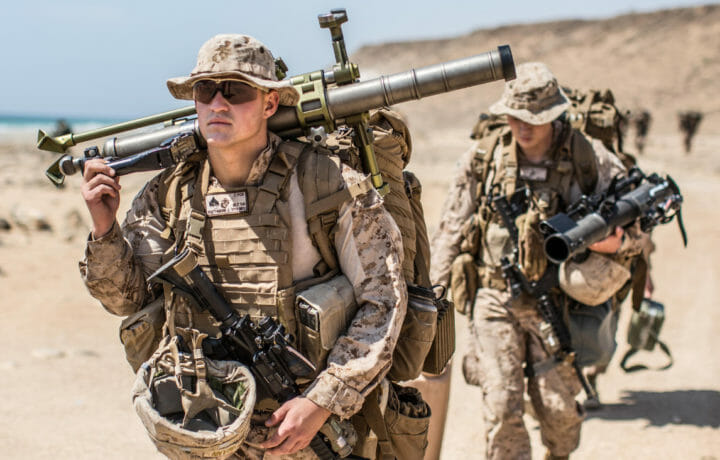November 10 marked the 245th anniversary of the United States Marine Corps – which back in 1775 was known as the Continental Marines. At the time, it consisted of two battalions with one Colonel, two lieutenant-colonels, two majors and other officers. Following the American Revolution, the Continental Marines, as part of the Continental Navy, was disestablished – but was reestablished in July 1798 under President John Adams.
The Marine Corps has played a role in every American conflict since then, and over the past 245 years this elite fighting force has continued to evolve. It is now undergoing its biggest transformation in decades.
Transformation Plan
In March, the Marine Corps announced it would undergo an ambitious 10-year transformation plan, which would see the service eliminate its entire tank force – including all of its tank battalions as well as its bridging companies and law enforcement battalions.
The changes are meant to allow the Marine Corps to be better optimized to meet the demands of the United States National Defense Strategy. This focus began last year when the service began force design activities focused on adapting capabilities to properly shape the Marine Corps’ contributions to naval warfare and joint force operations.
The Marine Corps is now making that transition from a “second land army” back to its maritime roots, which include defending ships at sea, island-hopping, and battling for contested coastlines, all in preparation for potential conflict with near-peer adversaries such as China.
As part of this ambitious plan, the USMC announced that it would also scale back the total number of infantry battalions from 24 to 21, artillery cannon batteries from 21 to five and amphibious vehicle companies from six to four. In addition, the Marines could cut back on the MV-22 Osprey, attack and heavy-lift squadrons – and would even reduce the number of F-35B and F-35C fifth-generation stealth fighters per squadron from 16 to just 10.
No More Tanks
The reorganization efforts have brought an end to the USMC 1st Tank Battalion, which was activated on November 1, 1941, at Camp Lejeune, North Carolina and attached to the 1st Marine Division. Tanks from Companies A and B took part in the landings at Guadalcanal in August 1942 and had their first major encounter with the enemy on August 21.
The Marine Corps has been steadily deactivating its tank units, and this month that included Bravo Company, 2d Tank Battalion. In accordance with Marine Corps Force Design 2030, the 2nd Tank Battalion was deactivated to optimize the Marine Corps’ ability to conduct naval expeditionary warfare.
In total, about 1,300 Marines will be impacted by the tank deactivations.
Landing Support
As tanks and bridging units are phased out, the Marine Corps reactivated the 2nd Landing Support Battalion at Camp Lejeune, North Carolina last month. The unit, which has a storied history and served in multiple overseas campaigns, hadn’t been active in more than four decades, but was reactivated as landing support units played a crucial role during World War II’s island hopping campaign.
The landing support units were among the first to reach the beaches, and could once again prove crucial in a peer-adversary conflict such as one with China.
“The re-establishment of 2nd Landing Support Battalion comes during a time of significant transformation within the Marine Corps. Small landing support elements will be vitally important to enable throughput and sustainment of distributed forces,” said Lt. Col. Randall L. Nickel, commanding officer of 2nd Landing Support Battalion in a statement. “Whether this is accomplished in the littorals via amphibious ships or via aerial delivery, landing support to the Fleet Marine Force is essential to ensure mission accomplishment.”
The 2nd Landing Support Battalion now consists of a Landing Support Company, a Beach and Terminal Operations Company, a Landing Support Equipment Company, and a Headquarters and Service Company. The Marine Corps said that the companies will be at the forefront of its renewed focus on expeditionary advanced base operations, a warfighting concept enabling a persistent forward naval presence that has long been the hallmark of U.S. expeditionary forces.
Marine Space Command
The Marine Corps isn’t just island hopping, and whether it will become a “planet hopping” force such as those seen in science fiction isn’t known, but the service does see a near future role in space. This month Marine Corps Commandant Gen. David Berger directed the activation of Marine Corps Forces Space Command (MARFORSPACE), which is based out of Offutt Air Force Base, Nebraska.
MARFORSPACE will focus on providing space operation support to the Fleet Marine Force, while also building a convergence capability that will increase warfighter lethality. The command’s first command is U.S. Marine Corps Maj. Gen. Matthew G. Glavy, who also serves as commander of the Marine Corps Forces Cyberspace Command.
“We have an incredible opportunity to create a synergy across the information environment based on our unique position within the naval and joint force,” Glavy said in a release. “Space and cyber are critical capabilities in the information environment that, when brought together, can provide a competitive advantage. Convergence requires flexible and interconnected teams focused on solving hard problems with speed. We cannot be successful in these technology-heavy domains without prioritizing people, ideas and things … in that order.”
MARFORSPACE will draw from the Marine Corps existing Forces Strategic Command. With this the “Marines’ Hymn” may need to be updated – but working in space and cyberspace to “We fight our country’s battles in the air, on land and sea,” could be quite the challenge.




